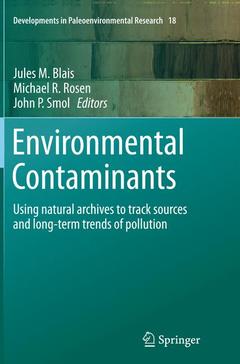Description
Environmental Contaminants, Softcover reprint of the original 1st ed. 2015
Using natural archives to track sources and long-term trends of pollution
Developments in Paleoenvironmental Research Series, Vol. 18
Coordinators: Blais Jules M., Rosen Michael R., Smol John P.
Language: English
Publication date: 10-2016
Support: Print on demand
Publication date: 04-2015
509 p. · 15.5x23.5 cm · Hardback
Description
/li>Contents
/li>Biography
/li>Comment
/li>
Using Natural Archives to Track Sources and Long-Term Trends of Pollution: An Introduction. Jules M. Blais, Michael R. Rosen, John P. Smol
The Influence of Hydrology on Lacustrine Sediment Contaminant Records. Michael R. Rosen
The Stability of Metal Profiles in Freshwater and Marine Sediments. P. M. Outridge and F. Wang
Calculating Rates and Dates and Interpreting Contaminant Profiles in Biomixed Sediments. Zou Zou A. Kuzyk, Robie W. Macdonald, Sophia C. Johannessen
Contaminants in Marine Sedimentary Deposits from Coal Fly Ash During the Latest Permian Extinction. Hamed Sanei, Stephen E. Grasb, and Benoit Beauchamp
Lake Sediment Records of Preindustrial Metal Pollution. Colin A. Cooke and Richard Bindler
Lacustrine Archives of Metals from Mining and Other Industrial Activities—A Geochemical Approach. John Boyle, Richard Chiverrell and Dan Schillereff
Organic Pollutants in Sediment Core Archives. Jennifer B. Korosi, Wenhan Cheng and Jules M. Blais
Environmental Archives of Contaminant Particles. Neil L. Rose and Meri Ruppel
Tracking Long-range Atmospheric Transport of Contaminants in Arctic Regions Using Lake Sediments. Jane Kirk and Amber Gleason
Tracking Long-Range Atmospheric Transport of Trace Metals, Polycyclic Aromatic Hydrocarbons, and Organohalogen Compounds Using Lake Sediments of Mountain Regions. Jordi Catalan
Using Peat Records as Natural Archives of Past Atmospheric Metal Deposition. Sophia V. Hansson, Richard Bindler and François De Vleeschouwer
Historical Contaminant Records from Sclerochronological Archives. Jessica Carilli, Branwen Williams, Bernd R. Schöne, Richard A. Krause and Stewart J. Fallon
Contaminant Records in Ice Cores. Paolo Gabrielli and Paul Vallelonga
Use of Catalogued Long-term Biological Collections and Samples for Determining Changes in Contaminant Exposure to Organisms. Linda M. Campbell and Paul Drevnick
Tracking Contaminant Transport From Biovectors. Roland Kallenborn and Jules M. Blais
Using Natural Archives to Track Sources and Long-Term Trends of Pollution: Some Final Thoughts and Suggestions for Future Directions. Jules M. Blais, Michael R. Rosen, and John P. Smol
Jules M. Blais, PhD is Professor of Biology and Environmental Toxicology at the University of Ottawa. He has published over 120 scientific articles on environmental chemistry and toxicology dealing especially with the behavior and fate of environmental contaminants and their impacts on lakes and northern communities. He is currently leading several projects on the effects of warming temperatures and resource extraction on freshwaters in Canada’s north, and is also working closely with federal regulators to investigate risks to northern populations by exposure to environmental contaminants from northern traditional diets and contaminated soils. He was recently named Environmental Scientist of the Year by the Royal Canadian Geographical Society (2008), and is co-recipient of the 2013 Brockhouse Canada Prize for outstanding contributions to interdisciplinary research, awarded by the Natural Sciences and Engineering Research Council of Canada. He is Associate Editor of Environmental Reviews, and serves on the editorial board of other journals. He founded and co-directs the Laboratory for the Analysis of Natural and Synthetic Environmental Toxicants, a major laboratory for the analysis of organic and metallic contaminants at the University of Ottawa. He is currently President of the Society of Canadian Limnologists, which is committed to the advancement of aquatic science and water issues in Canada.
Michael R. Rosen, PhD is Water Quality Specialist for the Western United States within the Water Science Field Team of the U.S. Geological Survey. He has been a research scientist with the U.S. Geological Survey since 2001. Before this, he was the Groundwater Quality Programme Leader at the Institute of Geological and Nuclear Sciences (now known as GNS Science), New Zealand, a research scientist at CSIRO, Australia, the Limnological Research Center, University of Minnesota, and Curtin University of Technology, Western Australia. He has published more
Summarizes the use of natural archives to assess human impacts on the environment and the history of contamination
Broadens the understanding to those who assess the environmental impacts of human activities
Maximizes reader insights into topics such as the influence of hydrology on lacustrine sediment contaminant records, lake sediment records of preindustrial metal pollution
Organic pollutants in sediment core archives, contaminant records in ice cores, and more
Includes supplementary material: sn.pub/extras




